Texas Railroad History - Tower 204 - Richardson
A Crossing of the Southern Pacific Railroad and the Gulf,
Colorado & Santa Fe Railway
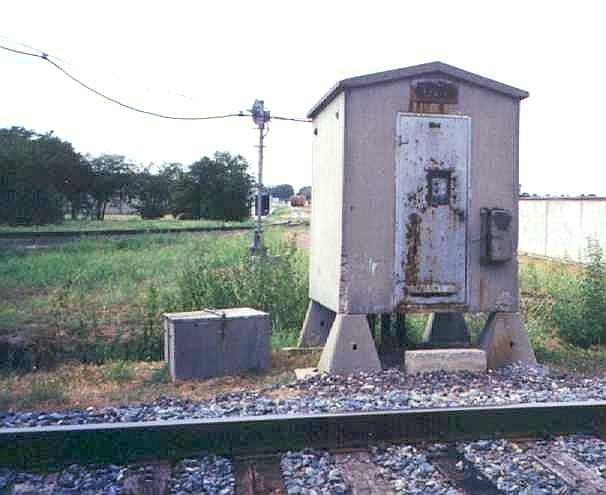 Left:
The cabin was standing, but the Tower 204 automatic interlocker was no longer in
service when photographed in 2005. The view is west along the Southern Pacific
(SP) "Arapaho Spur" which had passed to the right of the cabin and crossed the
Gulf, Colorado & Santa Fe (GC&SF) track (in front of the cabin.) Note that the
home signal behind the interlocker had been rotated 90 degrees
when it was taken out of service. The control box to the right of the cabin door housed the manual
override controls for the interlocker. (Jim King photo) Below:
current map of the Tower 204 area
Left:
The cabin was standing, but the Tower 204 automatic interlocker was no longer in
service when photographed in 2005. The view is west along the Southern Pacific
(SP) "Arapaho Spur" which had passed to the right of the cabin and crossed the
Gulf, Colorado & Santa Fe (GC&SF) track (in front of the cabin.) Note that the
home signal behind the interlocker had been rotated 90 degrees
when it was taken out of service. The control box to the right of the cabin door housed the manual
override controls for the interlocker. (Jim King photo) Below:
current map of the Tower 204 area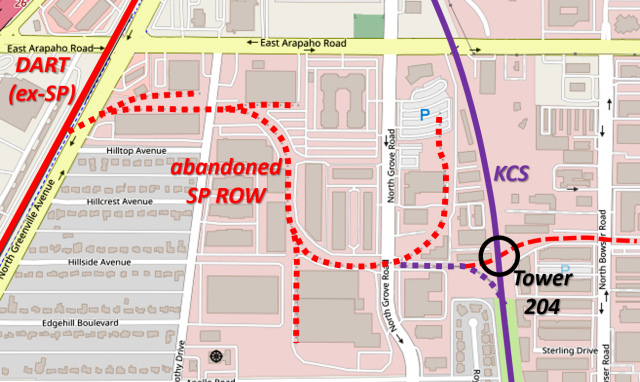
Map ((c)historicaerials.com) abbreviations: KCS: Kansas City Southern (which
acquired the line from the GC&SF); SP: Southern
Pacific; DART: Dallas Area Rapid Transit; ROW: right-of-way
Rollin Bredenberg provides this interesting history of
Tower 204:
In the mid 1950's, the Gulf, Colorado & Santa Fe (GC&SF) Railway decided to build a new line from Dalton Jct. (near
Denton) to Zacha Jct. (near Garland). Ben Biaggini, the Chief Engineer of the Texas & New Orleans
(T&NO) Railway, the Southern Pacific (SP) operating company in Texas, sought to keep the new
Santa Fe line from
denying SP future access to an area he thought would be rich with industrial
development likely to produce rail traffic. So, just before Santa Fe acquired the right of way for their
new Dallas
Subdivision, SP extended its existing "Arapaho Spur" across the planned Santa Fe alignment,
making SP the senior company at what would eventually become Tower 204.
Santa Fe's new 49.5-mile line between Dalton Jct. and Zacha
Jct. opened December 1, 1955, the last lengthy rail segment in Texas built on a
completely new right-of-way. The line provided direct access to
Dallas from the Santa Fe main line north of
Fort Worth which ran to Oklahoma and beyond. Until this "Dallas Cutoff" was built, Santa Fe's only tracks
through Dallas went southwest to Cleburne and northeast to
Paris. Paris was a
dead end; Santa Fe could exchange passengers and freight there with other
railroads but its tracks did not extend beyond Paris. Cleburne
was on Santa Fe's main line 29 miles south of
Fort Worth, hence it was not ideal for moving Dallas passengers and freight to and from Santa Fe's line
north of Fort Worth. Santa Fe had been
exercising limited rights to use the Texas & Pacific (T&P) Railway to reach
Dallas from Fort Worth, and they expected the Dallas Cutoff to provide a
significant improvement over the T&P option. In particular, the Dallas Cutoff allowed Santa
Fe to run a "Dallas stub connection" off of their Chicago -
Galveston passenger train, the
Texas Chief, at Gainesville near the Oklahoma border. There, the southbound Texas Chief
(train #15) set out Dallas-bound cars to be pulled by train #115 via Dalton Jct.
and Zacha Jct. to downtown Dallas where the train terminated at
Dallas Union
Station. Cars from the return train (#116) out of Dallas Union Station were
added to the northbound Texas Chief (#16) at Gainesville for the
trip to Oklahoma City and beyond. Trains #115 and #116 commenced operations on December 5, 1955, serving new stations at White
Rock (near Zacha Jct.) and Denton. Service was discontinued on July 19, 1968.
In
Richardson, the Dallas Cutoff crossed the Arapaho Spur, which came off of SP's line that dated back to the
1872 construction of the Houston &
Texas Central (H&TC) Railway into
Denison. By the 1980s, this line had become a secondary
route, and in 1988, SP sold it to the Dallas Area Rapid Transit (DART) system for use as a
light rail corridor. At the time of the sale, Santa Fe agreed to install a connection at Tower 204 to the Arapaho Spur (at DART expense) so that
service to customers on the spur could be maintained. The former SP tracks through
Richardson opened as the northern part of the DART Red Line in 2002.
 |
In the 1993-94 timeframe, Santa Fe sold the Dallas
Cutoff to Kansas City Southern (KCS) Railway. KCS had a long history of
activity in north Texas that dated back to 1939 when they acquired the
Louisiana & Arkansas (L&A) Railway. The L&A had a route between
Farmersville, on Santa Fe's Dallas - Paris line, and Shreveport. KCS
eventually obtained rights into Dallas via the Farmersville connection,
and they purchased the Santa Fe tracks south of Farmersville in the
early 1990s. KCS built a large yard along this track segment at Wylie
and was able to acquire rights (from DART) to operate on the former St.
Louis Southwestern (SSW) Railway line between Wylie and the Dallas
Cutoff. DART had bought the SSW right-of-way from SP in 1990 as a
potential light rail corridor. The location where it intersected the
Dallas Cutoff was named White Rock Junction by KCS, and a switch was
added to connect the former SSW route with the Dallas Cutoff
(previously, there were no connections; the crossing is grade separated.) The end result
was a KCS route that proceeded east on the Dallas Cutoff from Dalton
Jct. to White Rock Jct., and from there, east to Wylie on the former SSW
right-of-way.
From Wylie, KCS operated north to Farmersville on the former Santa
Fe line, and continued east from there to Greenville,
Pittsburg,
Jefferson and Shreveport on the former L&A
tracks. The remainder of the Dallas Cutoff between White Rock Jct. and Zacha Jct. was
relegated to secondary status by KCS. This is the track segment that passes
through the Tower 204
site.
Left: In
addition to SP, SSW and Santa Fe vintage tracks, the DART Blue Line
operates in this vicinity over Missouri - Kansas - Texas (MKT) heritage tracks
through the former Tower 78 crossing, as
does the Dallas, Garland and Northeastern (DG&NO) Railroad. |

Above: This annotated
1958 aerial image shows some kind of loading area along the Arapaho Spur
near Greenville Ave. The spur otherwise appears to have no customers,
hence the extension eastward across the planned Santa Fe right-of-way
was simply a gamble that business would develop in the long term.
((c)historicaerials.com) |

Above: This 2021
Google Earth image exposes the massive development that has occurred in
Richardson since 1958. One major new thoroughfare has been added, Grove
Rd., which is the yellow highlighted road that runs vertically near the
middle of the image, passing along the eastern edge of Blewett Cemetery
at Arapaho Rd. |
Due to the coordination between SP and Santa Fe, the
automatic interlocker commissioned as Tower 204 was most likely operational by
the time the Dallas Cutoff opened. After 1930, RCT no longer published an annual
list of active interlockers, so the precise date that Tower 204 was commissioned
is undetermined. When Santa Fe added the connection to the Arapaho Spur as a
result of the agreement with SP and DART in the early 1990s, there were
apparently no current customers east of Tower 204, because the diamond was
removed and the new Santa Fe connection only preserved customer service west of
Tower 204.
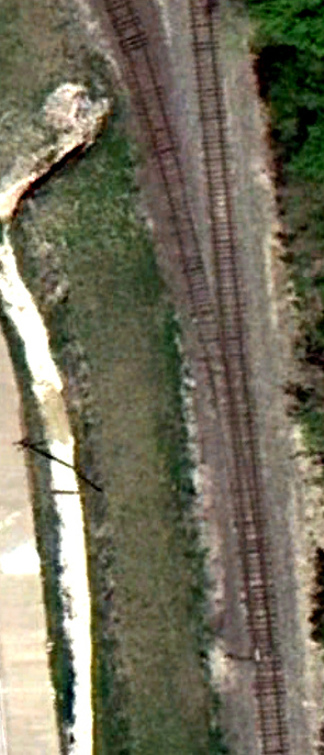
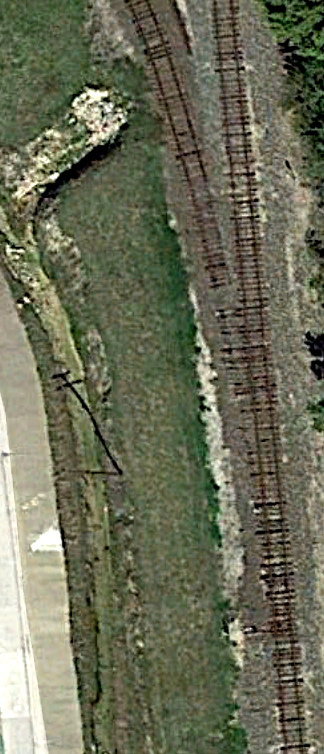
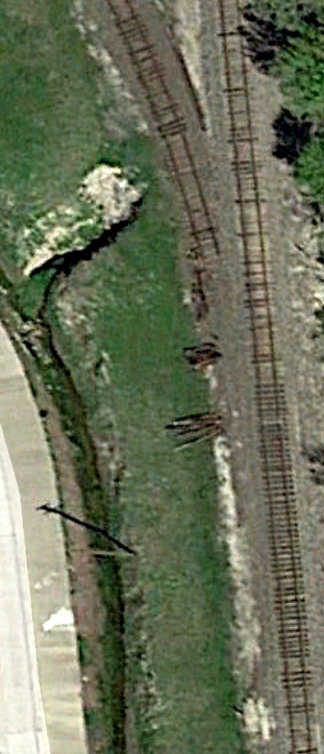
Above: The Arapaho Spur switch on KCS' track was still intact in March, 2011 (left).
It appears to have been disconnected by October, 2013 (center),
and was partially cleaned up by March, 2015 (right)
(Google Earth images.) Below:
In July, 2012, a timeframe midway between the left and center images above, the
spur might still have been connected to the KCS tracks. The Tower 204 cabin remains
trackside in the distance, but the home
signal visible in the earlier 2005 photo is no longer standing (Google Street View.)
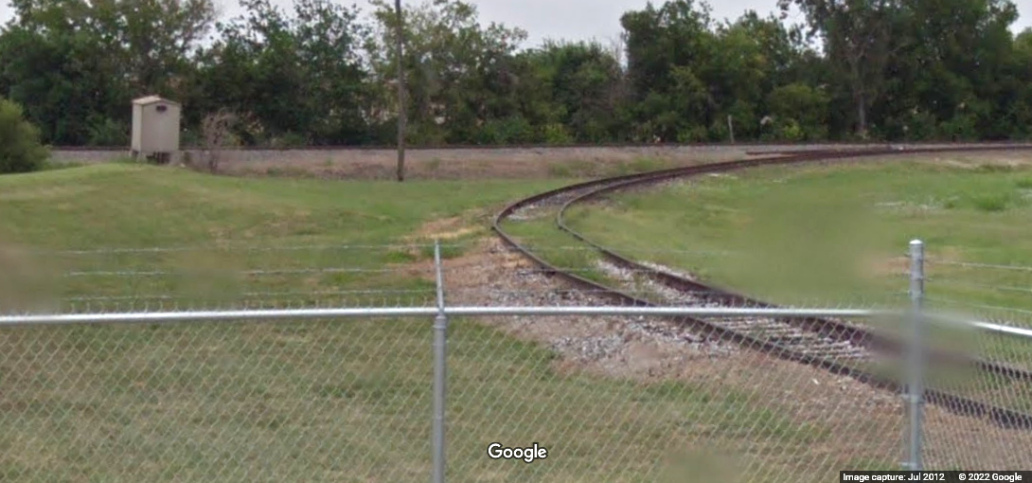
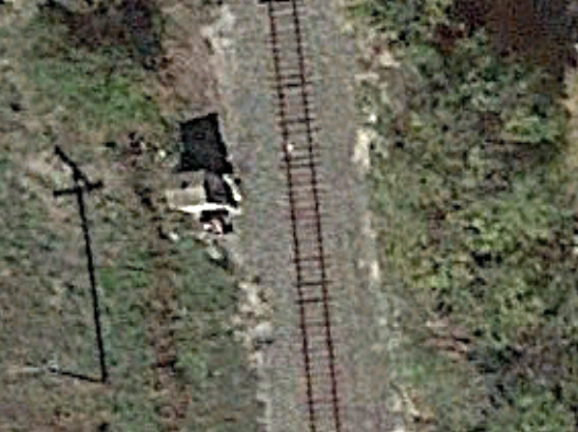
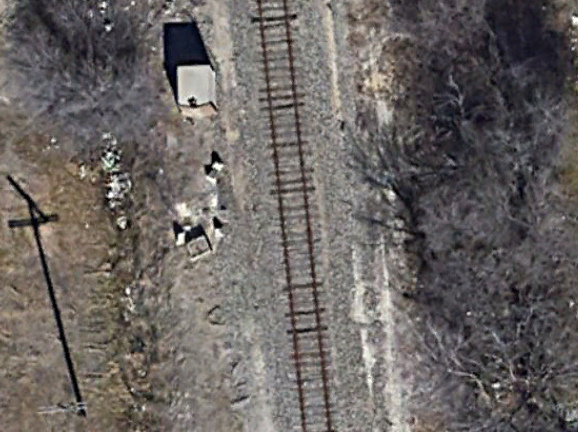
Above: Between November 2020 (left)
and November 2021 (right), the
concrete interlocker cabin was removed from its four pedestals, moved north
several feet, turned over onto its short side, and rotated 90 degrees. Perhaps
the work of vandals? The slightly peaked roof (missing its vent pipe) is now facing south, with the
cabin door on the underside against the ground. The back of the cabin faces the
sky. (Google Earth images)
Below: The Tower 204 cabin
remains on its side. The concrete box near the scattered pedestals is also
visible in the 2005 photo at top of page, but its purpose is undetermined. (Jim King photo, December 20, 2022)
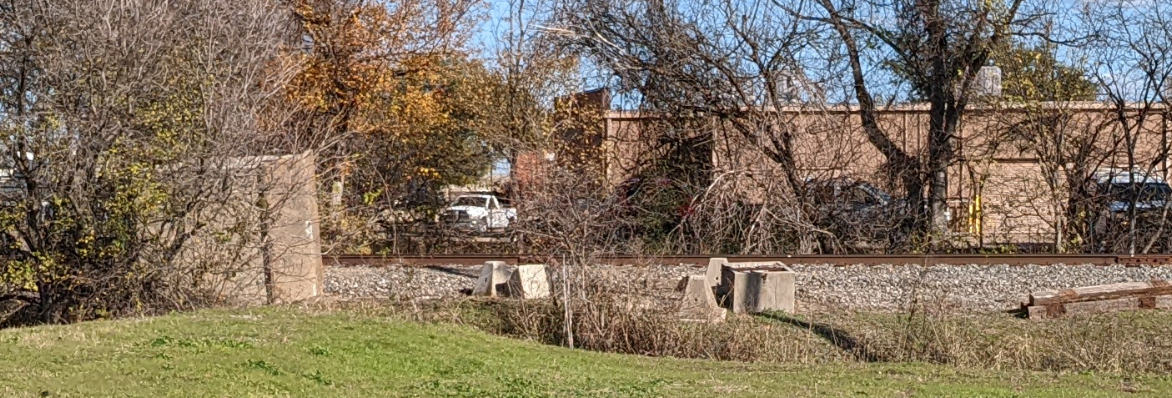
 Left:
The cabin was standing, but the Tower 204 automatic interlocker was no longer in
service when photographed in 2005. The view is west along the Southern Pacific
(SP) "Arapaho Spur" which had passed to the right of the cabin and crossed the
Gulf, Colorado & Santa Fe (GC&SF) track (in front of the cabin.) Note that the
home signal behind the interlocker had been rotated 90 degrees
when it was taken out of service. The control box to the right of the cabin door housed the manual
override controls for the interlocker. (Jim King photo) Below:
current map of the Tower 204 area
Left:
The cabin was standing, but the Tower 204 automatic interlocker was no longer in
service when photographed in 2005. The view is west along the Southern Pacific
(SP) "Arapaho Spur" which had passed to the right of the cabin and crossed the
Gulf, Colorado & Santa Fe (GC&SF) track (in front of the cabin.) Note that the
home signal behind the interlocker had been rotated 90 degrees
when it was taken out of service. The control box to the right of the cabin door housed the manual
override controls for the interlocker. (Jim King photo) Below:
current map of the Tower 204 area









